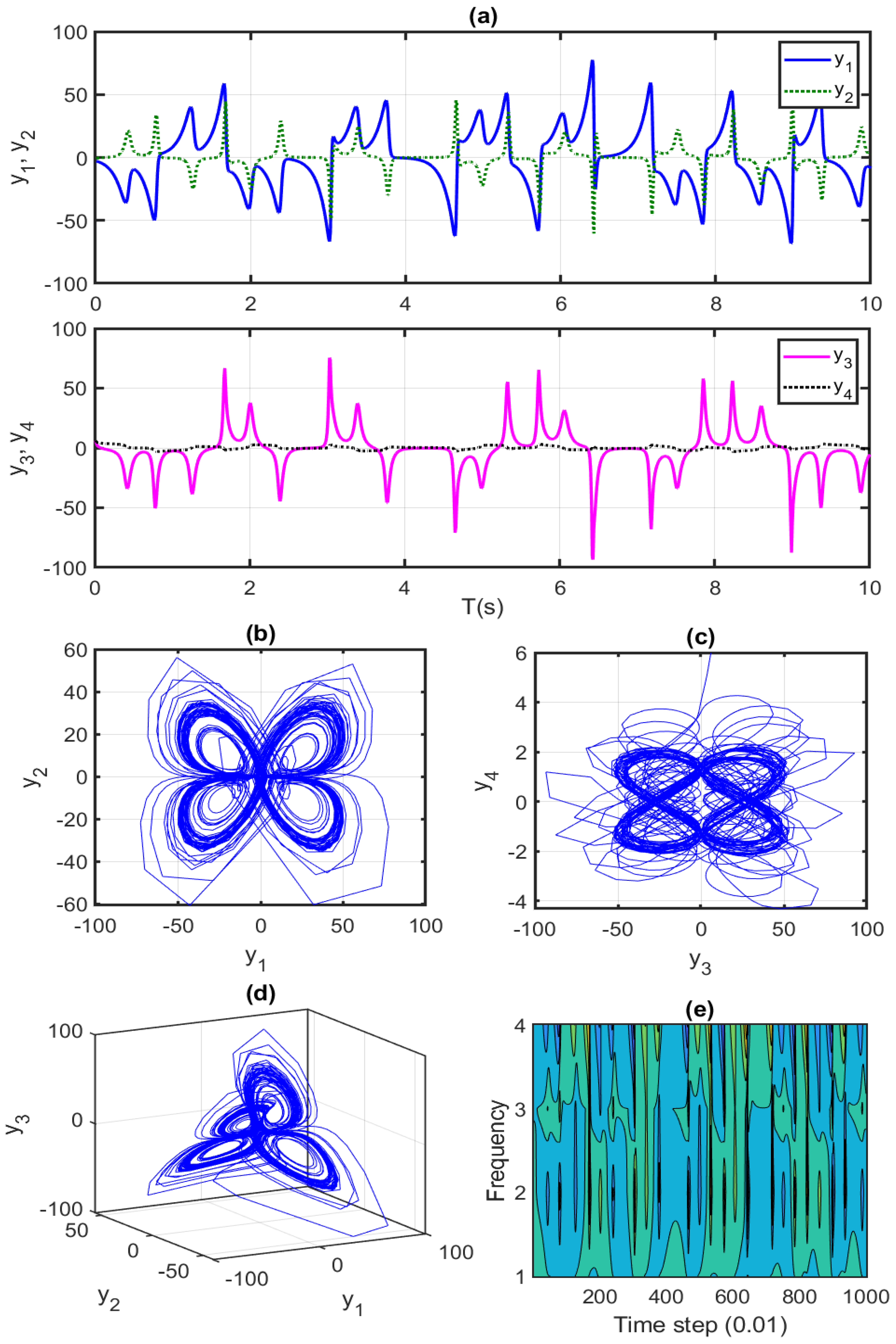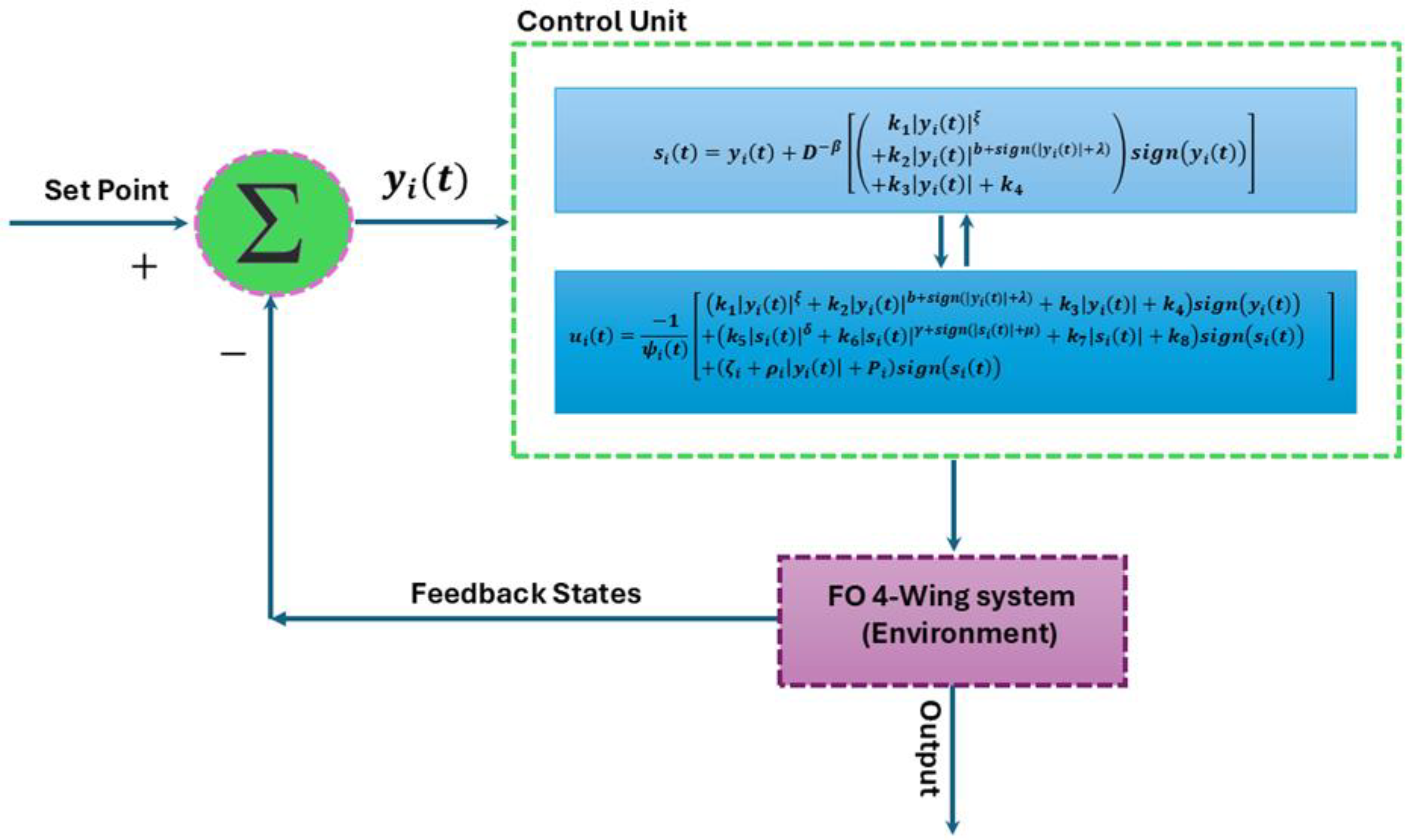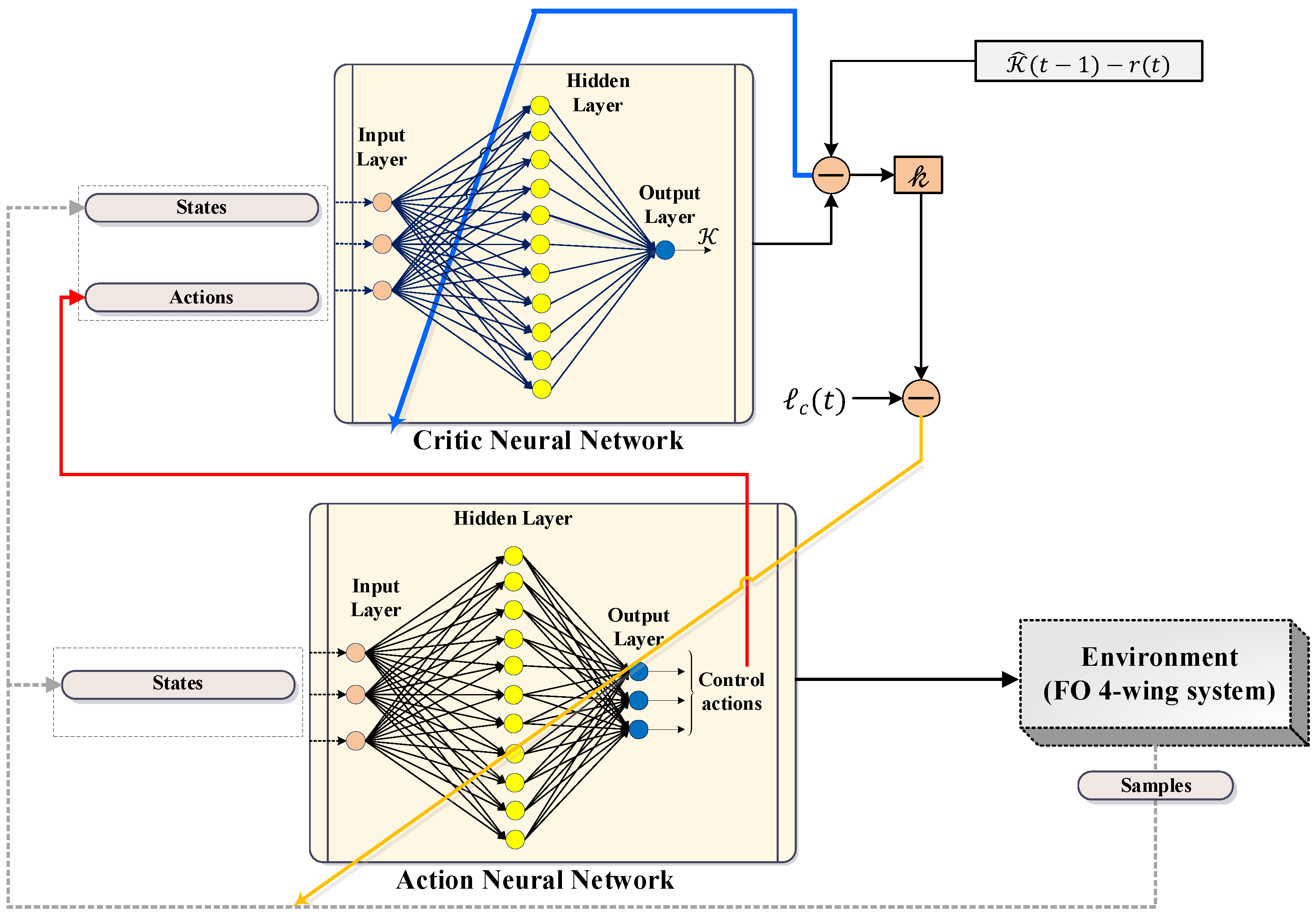Adaptive Dynamic Programming-Based Intelligent Finite-Time Flexible SMC for Stabilizing Fractional-Order Four-Wing Chaotic Systems
Abstract
1. Introduction
- Current research frequently depends predominantly on either linear or nonlinear elements when proposing control strategies, which restrict the overall robustness and adaptability of the methods.
- The application of SMC techniques is often associated with undesirable chattering effects, which are impractical in real-world scenarios.
- A significant portion of these studies oversimplifies system models by disregarding critical factors such as uncertainties, external disturbances, and input constraints, all of which play a vital role in practical systems.
- Nearly all of these approaches determine control parameters through conventional trial-and-error methods during simulations, which may not yield optimal or reliable results.
- Additionally, many of these studies fail to address or ensure finite-time stability, a crucial requirement for achieving rapid convergence and enhanced performance in dynamic systems.
- I.
- Introduction of a Novel Control Framework: This work presents a model-free FTF-SMC framework specifically tailored for control and stabilization of a FO 4-wing CS with input saturation.
- II.
- Finite-Time control Assurance: The proposed control strategy ensures finite-time control for a FO 4-wing CS, effectively addressing input saturation, and system uncertainties that have posed challenges in prior studies.
- III.
- System-Agnostic Design: The control laws are formulated to be independent of the specific system functions, leveraging the norm-boundedness property of chaotic system states. This enhances the methodology’s applicability across diverse chaotic systems.
- IV.
- Optimization via Adaptive Dynamic Programming (ADP) Algorithm: The study employs the ADP algorithm to fine-tune control parameters of the model-free FTF-SMC. The neural networks (action and critic networks) of ADP are trained in such a way that enhances controller adaptability by maximizing a reward signal.
- V.
- Comprehensive Validation: The efficacy of the proposed control strategy is validated through extensive simulations and two numerical case studies, demonstrating its practical relevance in engineering applications. A detailed comparison with an existing SMC method is also conducted, highlighting the superior performance of the proposed approach in terms of faster convergence, and enhanced robustness against uncertainties and disturbances. This comparative analysis underscores the advancements achieved by the proposed methodology over traditional SMC techniques.
- VI.
- Real-World Applicability: The robustness of the proposed FTF-SMC method in managing chaotic dynamics and input saturation highlights its potential for real-world engineering applications, particularly in complex system control.
2. Preliminary Concepts
- I.
- If , and belongs to the space , then the following holds:
- II.
- Suppose , and is a constant. In this case,
3. Problem Formulation and Design of Finite-Time PID Sliding Mode Control
3.1. Problem Statement
3.2. Design of the Finite-Time Flexible SMC
4. Parameter Design of FTF-SMC Based on Adaptive Dynamic Programming Learning
4.1. Principle of Adaptive Dynamic Programming Learning
4.2. Design of Model-Free FTF-SMC Based on Dynamic Programming Learning
5. Simulation Results and Analysis
5.1. Numerical Validation 1
5.2. Numerical Validation 2
6. Conclusions
Author Contributions
Funding
Institutional Review Board Statement
Informed Consent Statement
Data Availability Statement
Conflicts of Interest
References
- Pham, D.H.; Vu, M.T. Takagi–Sugeno–Kang Fuzzy Neural Network for Nonlinear Chaotic Systems and Its Utilization in Secure Medical Image Encryption. Mathematics 2025, 13, 923. [Google Scholar] [CrossRef]
- Nguyen, V.T.; Pham, D.H.; Nguyen, Q.C.; Vu, M.T. Optimal design of Takagi-Sugeno-Kang fuzzy neural network based on balancing composite motion optimization for chaotic synchronization with uncertainty and disturbance. Results Eng. 2025, 25, 104234. [Google Scholar] [CrossRef]
- Li, D.; Tong, S.; Yang, H.; Hu, Q. Time-Synchronized Control for Spacecraft Reorientation With Time-Varying Constraints. IEEE/ASME Trans. Mechatron. 2025, 33, 2073–2083. [Google Scholar] [CrossRef]
- Wang, F.; Chen, K.; Zhen, S.; Chen, X.; Zheng, H.; Wang, Z. Prescribed Performance Adaptive Robust Control for Robotic Manipulators With Fuzzy Uncertainty. IEEE Trans. Fuzzy Syst. 2024, 32, 1318–1330. [Google Scholar] [CrossRef]
- Ji, L.; Lin, Z.; Zhang, C.; Yang, S.; Li, J.; Li, H. Data-Based Optimal Consensus Control for Multiagent Systems With Time Delays: Using Prioritized Experience Replay. IEEE Trans. Syst. Man Cybern. Syst. 2024, 54, 3244–3256. [Google Scholar] [CrossRef]
- Ju, X.; Jiang, Y.; Jing, L.; Liu, P. Quantized predefined-time control for heavy-lift launch vehicles under actuator faults and rate gyro malfunctions. ISA Trans. 2023, 138, 133–150. [Google Scholar] [CrossRef]
- Liang, J.; Yang, K.; Tan, C.; Wang, J.; Yin, G. Enhancing High-Speed Cruising Performance of Autonomous Vehicles Through Integrated Deep Reinforcement Learning Framework. IEEE Trans. Intell. Transp. Syst. 2025, 26, 835–848. [Google Scholar] [CrossRef]
- Hu, J.; Chen, B.; Ghosh, B.K. Formation–Circumnavigation Switching Control of Multiple ODIN Systems via Finite-Time Intermittent Control Strategies. IEEE Trans. Control Netw. Syst. 2024, 11, 1986–1997. [Google Scholar] [CrossRef]
- Holden, A.V. Chaos; Princeton University Press: Princeton, NJ, USA, 2014. [Google Scholar]
- Zhang, X.; Liu, Y.; Chen, X.; Li, Z.; Su, C. Adaptive Pseudoinverse Control for Constrained Hysteretic Nonlinear Systems and its Application on Dielectric Elastomer Actuator. IEEE/ASME Trans. Mechatron. 2023, 28, 2142–2154. [Google Scholar] [CrossRef]
- Meng, Q.; Ma, Q.; Shi, Y. Adaptive Fixed-Time Stabilization for a Class of Uncertain Nonlinear Systems. IEEE Trans. Autom. Control 2023, 68, 6929–6936. [Google Scholar] [CrossRef]
- En-Zeng, D.; Zai-Ping, C.; Zeng-Qiang, C.; Zhu-Zhi, Y. A novel four-wing chaotic attractor generated from a three-dimensional quadratic autonomous system. Chin. Phys. B 2009, 18, 2680. [Google Scholar] [CrossRef]
- Alikhanov, A.A.; Asl, M.S.; Huang, C.; Apekov, A.M. Temporal second-order difference schemes for the nonlinear time-fractional mixed sub-diffusion and diffusion-wave equation with delay. Phys. D Nonlinear Phenom. 2024, 464, 134194. [Google Scholar] [CrossRef]
- Roohi, M.; Aghababa, M.P.; Haghighi, A.R. Switching adaptive controllers to control fractional-order complex systems with unknown structure and input nonlinearities. Complexity 2015, 21, 211–223. [Google Scholar] [CrossRef]
- Alikhanov, A.A.; Asl, M.S.; Huang, C. Stability analysis of a second-order difference scheme for the time-fractional mixed sub-diffusion and diffusion-wave equation. Fract. Calc. Appl. Anal. 2024, 27, 102–123. [Google Scholar] [CrossRef]
- Li, C.; Su, K.; Zhang, J.; Wei, D. Robust control for fractional-order four-wing hyperchaotic system using LMI. Optik 2013, 124, 5807–5810. [Google Scholar] [CrossRef]
- Li, C.; Tang, Z.; Yu, S. A new 4D four-wing hyperchaotic smooth autonomous system and its improved form. In Proceedings of the 2011 Fourth International Workshop on Chaos-Fractals Theories and Applications, Washington, DC, USA, 19–22 October 2011; pp. 18–21. [Google Scholar]
- Zhang, R.-X.; Yang, S.-P. Modified adaptive controller for synchronization of incommensurate fractional-order chaotic systems. Chin. Phys. B 2012, 21, 030505. [Google Scholar] [CrossRef]
- Dadras, S.; Momeni, H.R.; Qi, G.; Wang, Z.-l. Four-wing hyperchaotic attractor generated from a new 4D system with one equilibrium and its fractional-order form. Nonlinear Dyn. 2012, 67, 1161–1173. [Google Scholar] [CrossRef]
- Li, X.; Li, Z.; Wen, Z. One-to-four-wing hyperchaotic fractional-order system and its circuit realization. Circuit World 2020, 46, 107–115. [Google Scholar] [CrossRef]
- Zhang, L.; Sun, K.; He, S.; Wang, H.; Xu, Y. Solution and dynamics of a fractional-order 5-D hyperchaotic system with four wings. Eur. Phys. J. Plus 2017, 132, 31. [Google Scholar] [CrossRef]
- Li, D.; Dong, J. Fractional-Order Systems Optimal Control via Actor-Critic Reinforcement Learning and Its Validation for Chaotic MFET. IEEE Trans. Autom. Sci. Eng. 2025, 22, 1173–1182. [Google Scholar] [CrossRef]
- Roohi, M.; Mirzajani, S.; Haghighi, A.R.; Basse-O’Connor, A. Robust stabilization of fractional-order hybrid optical system using a single-input TS-fuzzy sliding mode control strategy with input nonlinearities. AIMS Math. 2024, 9, 25879–25907. [Google Scholar] [CrossRef]
- Roohi, M.; Mirzajani, S.; Basse-O’Connor, A. A no-chatter single-input finite-time PID sliding mode control technique for stabilization of a class of 4D chaotic fractional-order laser systems. Mathematics 2023, 11, 4463. [Google Scholar] [CrossRef]
- Mirzajani, S.; Aghababa, M.P.; Heydari, A. Adaptive T–S fuzzy control design for fractional-order systems with parametric uncertainty and input constraint. Fuzzy Sets Syst. 2019, 365, 22–39. [Google Scholar] [CrossRef]
- Wei, Y.; Sheng, D.; Chen, Y.; Wang, Y. Fractional order chattering-free robust adaptive backstepping control technique. Nonlinear Dyn. 2019, 95, 2383–2394. [Google Scholar] [CrossRef]
- Tajrishi, M.A.Z.; Kalat, A.A. Fast finite time fractional-order robust-adaptive sliding mode control of nonlinear systems with unknown dynamics. J. Comput. Appl. Math. 2024, 438, 115554. [Google Scholar] [CrossRef]
- Hu, K.; Ma, Z.; Zou, S.; Li, J.; Ding, H. Impedance Sliding-Mode Control Based on Stiffness Scheduling for Rehabilitation Robot Systems. Cyborg Bionic Syst. 2024, 5, 99. [Google Scholar] [CrossRef]
- Li, X.; Rao, R.; Zhong, S.; Yang, X.; Li, H.; Zhang, Y. Impulsive control and synchronization for fractional-order hyper-chaotic financial system. Mathematics 2022, 10, 2737. [Google Scholar] [CrossRef]
- Oshnoei, S.; Aghamohammadi, M.R.; Khooban, M.-H. Model-free predictive frequency control under sensor and actuator FDI attacks. IEEE Trans. Circuits Syst. II Express Briefs 2023, 71, 2434–2438. [Google Scholar] [CrossRef]
- Lv, J.; Ju, X.; Wang, C. Neural network prescribed-time observer-based output-feedback control for uncertain pure-feedback nonlinear systems. Expert Syst. Appl. 2025, 264, 125813. [Google Scholar] [CrossRef]
- Zou, Z.; Yang, S.; Zhao, L. Dual-loop control and state prediction analysis of QUAV trajectory tracking based on biological swarm intelligent optimization algorithm. Sci. Rep. 2024, 14, 19091. [Google Scholar] [CrossRef]
- Mathiyalagan, K.; Sangeetha, G. Second-order sliding mode control for nonlinear fractional-order systems. Appl. Math. Comput. 2020, 383, 125264. [Google Scholar] [CrossRef]
- Dou, B.; Yue, X. Fractional-Order Sliding Mode Control for Free-Floating Space Manipulator With Disturbance and Input Saturation. Int. J. Robust Nonlinear Control 2025, 35, 3094–3115. [Google Scholar] [CrossRef]
- Chen, L.; Wu, R.; He, Y.; Chai, Y. Adaptive sliding-mode control for fractional-order uncertain linear systems with nonlinear disturbances. Nonlinear Dyn. 2015, 80, 51–58. [Google Scholar] [CrossRef]
- Saif, A.W.A.; Gaufan, K.B.; El-Ferik, S.; Al-Dhaifallah, M. Fractional Order Sliding Mode Control of Quadrotor Based on Fractional Order Model. IEEE Access 2023, 11, 79823–79837. [Google Scholar] [CrossRef]
- Mahmoud, T.A.; El-Hossainy, M.; Abo-Zalam, B.; Shalaby, R. Fractional-order fuzzy sliding mode control of uncertain nonlinear MIMO systems using fractional-order reinforcement learning. Complex Intell. Syst. 2024, 10, 3057–3085. [Google Scholar] [CrossRef]
- Gokyildirim, A.; Calgan, H.; Demirtas, M. Fractional-Order sliding mode control of a 4D memristive chaotic system. J. Vib. Control 2024, 30, 1604–1620. [Google Scholar] [CrossRef]
- Baishya, C.; Premakumari, R.N.; Samei, M.E.; Naik, M.K. Chaos control of fractional order nonlinear Bloch equation by utilizing sliding mode controller. Chaos Solitons Fractals 2023, 174, 113773. [Google Scholar] [CrossRef]
- Feliu-Talegón, D.; Rafee Nekoo, S.; Tapia, R.; Acosta, J.Á.; Ollero, A. Practical fractional-order terminal sliding-mode control for a class of continuous-time nonlinear systems. Trans. Inst. Meas. Control 2025. [Google Scholar] [CrossRef]
- Wang, F.-X.; Cui, J.-Q.; Zhang, J.; Lu, Y.-F.; Liu, X.-G. Stabilization of fractional nonlinear systems with disturbances via sliding mode control. Int. J. Robust Nonlinear Control 2025, 35, 202–221. [Google Scholar] [CrossRef]
- Znidi, A.; Nouri, A.S. Discrete adaptive sliding mode control for uncertain fractional-order Hammerstein system. Trans. Inst. Meas. Control 2025. [Google Scholar] [CrossRef]
- Narayanan, G.; Ali, M.S.; Joo, Y.H.; Perumal, R.; Ahmad, B.; Alsulami, H. Robust Adaptive Fractional Sliding-Mode Controller Design for Mittag-Leffler Synchronization of Fractional-Order PMSG-Based Wind Turbine System. IEEE Trans. Syst. Man Cybern. Syst. 2023, 53, 7646–7655. [Google Scholar] [CrossRef]
- Roohi, M.; Mirzajani, S.; Haghighi, A.R.; Basse-O’Connor, A. Robust Design of Two-Level Non-Integer SMC Based on Deep Soft Actor-Critic for Synchronization of Chaotic Fractional Order Memristive Neural Networks. Fractal Fract. 2024, 8, 548. [Google Scholar] [CrossRef]
- Podlubny, I. Fractional Differential Equations: An Introduction to Fractional Derivatives, Fractional Differential Equations, to Methods of Their Solution and Some of Their Applications; Elsevier Science: Amsterdam, The Netherlands, 1998. [Google Scholar]
- Li, C.; Deng, W. Remarks on fractional derivatives. Appl. Math. Comput. 2007, 187, 777–784. [Google Scholar] [CrossRef]
- Li, Y.; Chen, Y.; Podlubny, I. Stability of fractional-order nonlinear dynamic systems: Lyapunov direct method and generalized Mittag–Leffler stability. Comput. Math. Appl. 2010, 59, 1810–1821. [Google Scholar] [CrossRef]
- Pan, W.; Li, T.; Sajid, M.; Ali, S.; Pu, L. Parameter identification and the finite-time combination–combination synchronization of fractional-order chaotic systems with different structures under multiple stochastic disturbances. Mathematics 2022, 10, 712. [Google Scholar] [CrossRef]
- Curran, P.; Chua, L. Absolute stability theory and the synchronization problem. Int. J. Bifurc. Chaos 1997, 7, 1375–1382. [Google Scholar] [CrossRef]
- Fradkov, A.L.; Evans, R.J. Control of chaos: Methods and applications in engineering. Annu. Rev. Control 2005, 29, 33–56. [Google Scholar] [CrossRef]
- Asl, M.S.; Javidi, M. Numerical evaluation of order six for fractional differential equations: Stability and convergency. Bull. Belg. Math. Soc. -Simon Stevin 2019, 26, 203–221. [Google Scholar] [CrossRef]
- Alikhanov, A.A.; Yadav, P.; Singh, V.K.; Asl, M.S. A high-order compact difference scheme for the multi-term time-fractional Sobolev-type convection-diffusion equation. Comput. Appl. Math. 2025, 44, 115. [Google Scholar] [CrossRef]
- Alikhanov, A.A.; Asl, M.S.; Li, D. A novel explicit fast numerical scheme for the Cauchy problem for integro-differential equations with a difference kernel and its application. Comput. Math. Appl. 2024, 175, 330–344. [Google Scholar] [CrossRef]
- Wang, B.; Ding, J.; Wu, F.; Zhu, D. Robust finite-time control of fractional-order nonlinear systems via frequency distributed model. Nonlinear Dyn. 2016, 85, 2133–2142. [Google Scholar] [CrossRef]










Disclaimer/Publisher’s Note: The statements, opinions and data contained in all publications are solely those of the individual author(s) and contributor(s) and not of MDPI and/or the editor(s). MDPI and/or the editor(s) disclaim responsibility for any injury to people or property resulting from any ideas, methods, instructions or products referred to in the content. |
© 2025 by the authors. Licensee MDPI, Basel, Switzerland. This article is an open access article distributed under the terms and conditions of the Creative Commons Attribution (CC BY) license (https://creativecommons.org/licenses/by/4.0/).
Share and Cite
Vu, M.T.; Kim, S.H.; Pham, D.H.; Thanh, H.L.N.N.; Pham, V.H.; Roohi, M. Adaptive Dynamic Programming-Based Intelligent Finite-Time Flexible SMC for Stabilizing Fractional-Order Four-Wing Chaotic Systems. Mathematics 2025, 13, 2078. https://doi.org/10.3390/math13132078
Vu MT, Kim SH, Pham DH, Thanh HLNN, Pham VH, Roohi M. Adaptive Dynamic Programming-Based Intelligent Finite-Time Flexible SMC for Stabilizing Fractional-Order Four-Wing Chaotic Systems. Mathematics. 2025; 13(13):2078. https://doi.org/10.3390/math13132078
Chicago/Turabian StyleVu, Mai The, Seong Han Kim, Duc Hung Pham, Ha Le Nhu Ngoc Thanh, Van Huy Pham, and Majid Roohi. 2025. "Adaptive Dynamic Programming-Based Intelligent Finite-Time Flexible SMC for Stabilizing Fractional-Order Four-Wing Chaotic Systems" Mathematics 13, no. 13: 2078. https://doi.org/10.3390/math13132078
APA StyleVu, M. T., Kim, S. H., Pham, D. H., Thanh, H. L. N. N., Pham, V. H., & Roohi, M. (2025). Adaptive Dynamic Programming-Based Intelligent Finite-Time Flexible SMC for Stabilizing Fractional-Order Four-Wing Chaotic Systems. Mathematics, 13(13), 2078. https://doi.org/10.3390/math13132078








